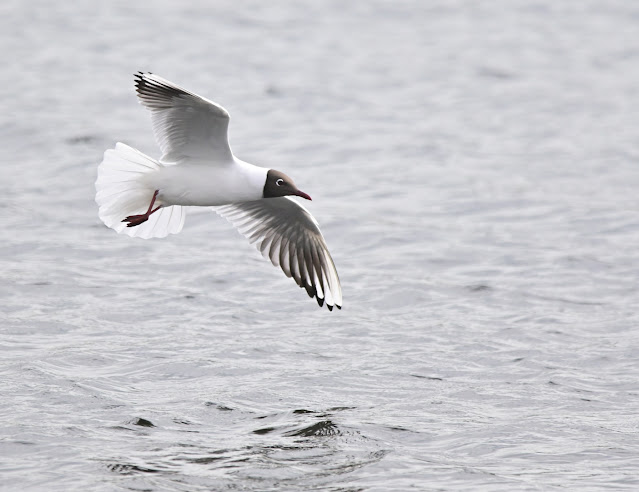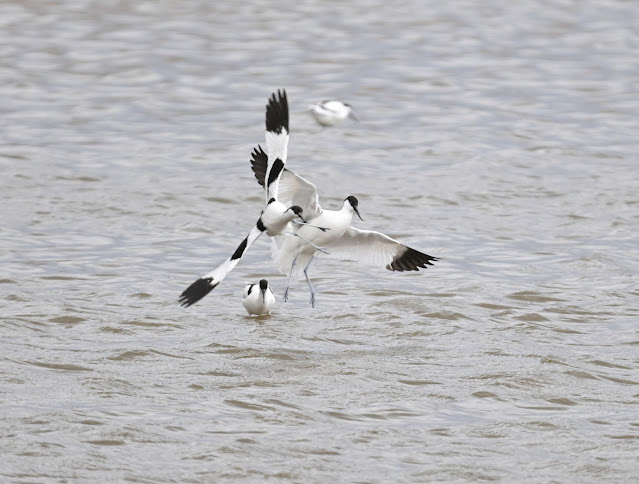The Safari was up at Leighton Moss with CR again after a weather induced decision took us away from our prefered venture into south Cumbria where we had hoped to fettle out some scaly things. The weather forecast had other ideas though and told us to expect wintery showers thick and fast throughout the day. So change of venue it was and not to worry as Leighton Moss had a pair of Garganey recently arrived and the prospect of smaller arrivals in the form of Willow Warblers and Blackcaps to look forward to as well as the possibility of an Osprey going over and the resident Bitterns, Cetti's Warblers and Bearded Tits and maybe even a Jay (no chance!) to add to our Challenge tally.
News on the street was that the Garganey were at the Grisedale hide so that's where we set off for first. Once at the hide we learnt we'd arrived about half an hour after an Osprey had passed through...would there be another one later?????. But there was no sign of the Garganey. In fact there wasn't much sign of anything although to be fair Cetti's Warblers taunted and teased us by signing from invisible locations and Bitterns boomed similarly invisibly. The light was atrocious too, those regular showers didn't materialise and we had bright sunshine all morning making viewing in to the light awkward and uncomfortable at times with the glare off the water. Then something unseen flushed a small group of Teal from the left which flew across in front of the hide and landed away to the right, but following them, swimming rather than flying, was the pair of Garganey. Why the shout hadn't gone up from the left hand side of the hide we don't know but they were getting to the point of no return into the bad light when we picked them up and spread the word.
They sailed passed us and settled in a really bad patch of glare, impossible to get any more pics. #128.A quick look from Tim Jackson Hide wasn't up to much so we opted to head for the causeway and break open the butty box there passing through Lillian's Hide on the way. Again there wasn't too much to be had at Lillian's and looking anywhere right of straight out was difficult due to the glare, we tried to look through the diving duck flock to see if the female Ring Necked Duck was still present but to be honest it was hard enough to tell Pochards from Tufted Ducks the light was that bad.
As usual while we're on safari we keep a tally of Egrets v Herons. By now Egrets had a slight upper hand by now but for a change Herons weren't going to beaten easily today although they are hard to keep a track of as they move around a bit and accidental double counting can easily come into play. With not much to aim the camera at here and Heron's being big and slow we tried a bit of BiF photography, one day we hope to get the hang of it!
It was that bad we were reduced to aiming at a small clump of Marsh Marigolds in front of the hide.We were about to leave when the first of the day's showers struck. We stayed put and waited for the Sand Martins to drop out of the sky - none did! The rain didn't last long and now that our butty boxes were empty we set off back towards the Garganeys. The woods were still quiet, no Willow Warblers nor Blackcaps had arrived. But just as we got back to the Causeway a Blackcap briefly sang a few notes, good to get one on the day list but no chance of a pic of it in the dense Blackthorn thicket. The Causeway hide was full to busting so we went straight through even though there were point blank Tufted Ducks in nice light right outside the window. A quick look from the screen outside the far door gave us a consolation not too distant drake Pochard.Along the causeway a male Marsh Harrier began to come into range but veered away rather than posing for pics, we did get our first (and only as it happens) Water Rail of day, sqealing from the reeds to our left. A brief stop at the feeders had a camera-shy pair of Bullfinches and a brief view of a Treecreeper but not much else. Continuing directly to the Grisedale Hide we passed a singing Chiffchaff along the path just past the visitor centre.On reaching the Grisedale Hide the light wwas better than earlier, or at least not so much in your face, hard right was harsh light. But there was a bit more activity. A couple of Marsh Harriers cruised aroundGrey Lag Geese noisily came and wentAnd in theafternoon sunshine the Teal looked particularly splendid.
The males are easy to appreciate with their colourful heads with the gold pencil lines and their filigree vermiculated flanks but the females are also striking in a more subtle way with spots and speckles in a multitude of hues of brown and cream.
The Osprey nesting tower has once again been taken over by one of the resident pairs of Great Black Backed Gulls - woe betide any Osprey that tries to displace them! It might be wise for the reserve to cover the the platform until the Ospreys start to arrive in numbers but even then there's no guarantee the gulls wouldn't get there first. Both, however, are Amber Listed in the UK although the Great Black backed Gull population is about 15,000 pairs compared to only 250 pairs of Ospreys, the latter are rapidly increasing while the gulls are just about stable with maybe a slight increase in recent years.
Great to see them, somehow we didn't come across them at all last year.
And were joined by a couple of others from further away across the pool.There were some on the nearest vegetated island that appeared to be feeding, on what exactly???A large flcok of Black Tailed Godwits in the middle of the pool was disturbed by something unseen, or they had just managed to frighten themselves, but once in the air it broke up into smaller groups ansd a couple of them landed quite close. Great to see them attaining their brick red summer plumage.
 |
We were told of a Green Winged Teal that had been seen earlier but hadn't been seen since a passing Marsh Harrier had spooked everything. We failed to find it, there's more than plenty of places it could have been hiding. There'd been a second Mediterranean Gull earlier too but we still couldn't find the one we'd originally seen from the Allen Hide.
Then all to soon it was time to brave the Bank Holiday traffic and head back to Base Camp. We needn't have worried the traffic going our way wasn't too bad but we certainly wouldn't have fancied being stuck in the miles of dead slow tail back heading up to the Lake District or Scotland.
Back at Base Camp we've been keeping an eye on the local birds, here's one half of one of the two local pairs of Dunnocks that came for easy pickings while we had taken a break from topping up the feeders and left them stood on the potting bench/moth trap table at the bottom of the garden.

Where to next? Hopefully the weather will improve and we'll get out on safari and find something that isn't birds for a change.
In the meantime let us know what the soundtrack of your outback is.






































No comments:
Post a Comment